Sustainability in Project and Portfolio Management
Developed by Erika di Pietro
In the past, there was not desire to know the ecological impact of products, since environmental disasters were rather rare. Conversely, today several companies have adopted sustainable strategies as long term value in their business model, in order to face environmental problems as population growth, climate change and divergent living standards. However, there is still a huge need to change the way in which companies and the society produce and consume goods.
All the environmental, social and economics issues, have been collected into a global program, Sustainable Development Goals (SDGs)[1], containing 17 goals and 169 targets, integrated and indivisible, aiming to address the world behaviour on a sustainable path.
Governments have already agreed to follow the SDGs, now the missing piece are the companies, aligning organizational business within SDGs. Tools and knowledge useful for organisations, to achieve this balance, are offered by the SDG Compass.
Sustainability integrated with portfolio management implies many changes in the operations, focusing on material issues, engaging with diverse stakeholders, managing climate and resource related risks, creating new sustainability driven opportunities, and reporting transparently on actions and performance.
Organizational culture is defined as: “The values and behaviours that contribute to the unique social and psychological environment of an organization”[2]. The way the culture is expressed by the leaders and the employees impacts relationship with external and internal stakeholders and the company efficiency in general. It is important to understand, how a shared vision and a common culture of sustainability is necessary to be created and promoted, to facilitate organizational understanding of core values and to help project mangers better understanding and leading a good alignment between goals and outcomes.
Driving a sustainable strategy into an organization requires senior management to communicate the vision clearly. Sustainability gives the organization a big competitive advantage, increasing expectations by stakeholders, obtaining radical transparency and contributing to support declining resources.
Contents |
A holistic perspective
The most quoted definition of Sustainability, in terms of Sustainable Development, tracks back to the Brundtland Commission of the United Nations on March 20, 1987 "Development that meets the needs of the present without compromising the ability of future generations to meet their own needs". [3] This concept of thinking in the long term is becoming broaden in the business philosophy. Also if, as the famous economist John Maynard Keynes said, “In the long run we are all dead”[4], this means that any long-term policy is going to fail if the company is not able to survive in short-term business conditions. Shifting from a daily profit-making company into a sustainable company requires a change in perspective, from the short to the long term.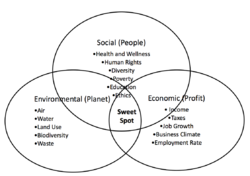
History says that many companies tried to become environmental friendly; for example, in 1975 the US company 3M set up the Pollution Prevention Pays (3P) programme, aiming to reduce costs by preventing waste and emission, a very sustainable entrepreneurial project at that time. Furthermore, the company found out that was reducing costs in maintenance, raw materials, accidents, clean-up operations and insurance. The inventor of the 3P programme is Joseph Ling, who affirmed that the environmental challenge for the next millennium "Is to move from pollution prevention toward sustainable development and design for environment" [6].
Then, producing without pollution is not enough, it is necessary that products and the whole system is reviewed and redesigned in order to fulfil the costumer and the organization needs in a sustainable manner. Through an holistic concept of sustainability, in terms of Corporate Business, a three-pronged approach takes place: the Triple Bottom Line (TBL)(Figure 1), introduced by John Elkington in 1994, where economic, environmental and social goals are aligned and impact on the decision and actions of the organization. [5]
This concept is present in the UN World Business Council for Economic Development (WBCSD)[7], formed by 150 international companies worldwide, where leaders involve the TBL in their business case, in order to address global challenges such as poverty, gender inequality, resource depletion, etc.
The WBCSD recommends to the companies to follow the Sustainable Development Goals (SDGs) as opportunity for business and to have more influence on the society.
Developing a business case following the values and preposition of a sustainable development it is a entrepreneurial step, in the life cycle of a company, providing competitive advantages and new opportunities.
The Sustainability Journey
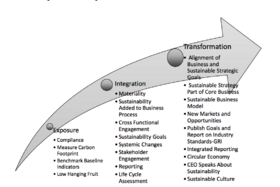
The vision of sustainable value offers a compelling challenge to business. Companies that choose to start the “sustainability journey” have to go through different stages, in order to build a strong basis to be able to run for the long-term :
-Exposure : includes energy savings, building efficiency and compliance projects.
-Integration : more holistic approach, starts including LCA [9]. Better understanding of the positive relation between sustainability and business strategy.
-Transformation : the peak of the organizational change, when sustainability becomes part of the core strategic vision of the company, being part of all the decision, processes and metrics for success.
The different stages are reflected into the SDG Compass[8] ,the Un Global Compact [10], as well as in the SDG Industry Matrix[11], guiding managers in the alignment of the company strategies within the sustainable goals.
SDG Compass
SDGs call businesses to contribute around a common framework with creativity and innovation to solve sustainable development challenges, providing the SDG Compass. Each SDG provides an opportunity for business, especially SDG12 [12] ( Ensure sustainable consumption and production patterns) and SDG 17[13] (Strengthen the means of implementation and revitalize the global partnership for sustainable development).
The SDG Compass[8] is a guide for companies and explains how they can align their strategies, measuring and managing their contribution in order to achieve the SDGs.
This guidance is designed with a focus on multinational companies, but small and medium enterprises are invited to use it as a source of inspiration and adapt as necessary. [5]
SDG Compass provides five steps that companies have to follow, always depending on where they are in there sustainability journey: understanding the SDGs, defining priorities, setting goals, integrating, reporting and communicating.
Understanding the SDGs
It includes the familiarization with SDGs and the understanding of the opportunities for the business:
-Identifying future business opportunities
-Enhancing the value of corporate sustainability
-Strengthening stakeholder relations and keeping pace with policy developments
-Stabilizing societies and markets
-Using a common language and shared purpose.
Defining Priorities
The contribution of the company to each SDG and the risks and opportunities they can represent, will depend on different factors.
Map the Value chain to identify impact areas
First of all, it is very important that the company analyze the entire value chain, from the supply base and inbound logistics, across production and operations, use to the end of life of the products. Secondly, the company should start the impact assessment, realising a high level mapping of its entire value chain, as in the Figure 3. However, the map recognizes, along the value chain, where greatest impacts can be expected. This is very relevant, because studying every fragment of the chain, are identified areas where :
- Company’s competencies, technologies and product portfolio contribute positively to the implementation of one or more SDGs.
- Company’s activities have, directly or indirectly, negative impacts on one or more SDGs.
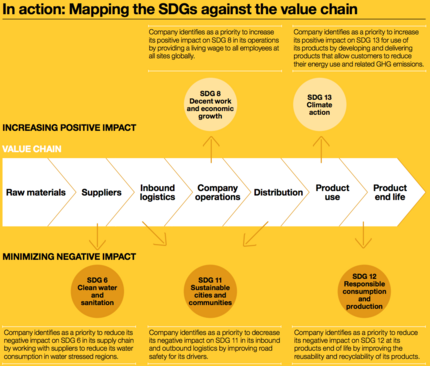
With the impact assessment, it will be possible to scale up positive impacts or reduce the negative one. Moreover, the transparency about the boundaries that have been selected and businesses that have been excluded, is very important for the company’s image, trust and for possible partnerships.
During the assessment and the mapping, the company should consider the surroundings, such as the proximity to geographical areas with low performance related to SDGs.
If the company do not find the impact areas on the industry sector data, there are some tools or methodologies to help them to recognise these areas, listed in the following table:
| Tools and methodologies | Explanation |
|---|---|
| GHG Protocol Scope 3 Evaluator[14] | is a free web-based tool, which allows the company to measure, report, and reduce emissions at every stage of its value chain. |
| Hotspots Database[15] | allows the company to model supply chains by country-specific-sectors, calculate labor intensity, and report on the share of worker hours at risk of social impacts. |
| Rights and Business Country Guide[16] | sustains the company to identify, assess and address their human rights impact |
| WBCSD Global Water Tool[17] | is a free, publicly available resource for identifying corporate water risks and opportunities which provides easy access to and analysis of critical data. |
| Poverty Footprint Tool[18] | examines the company's effect on society throughout the business model |
In order to map the value chain of the company, internal and external stakeholders have to be engaged. Developing a particular attention on their issues, needs, interests, it is easier to assess correctly the potential impact of the company on the SDGs. Even if sometimes stakeholders will not provide a complete understanding of the impact areas, often they help to have a wider perspective, thanks to information exchange.
Speaking in terms of portfolio and project management, there are different techniques to maximize the stakeholder engagement. Also if the manager is not sure about the contribution of some stakeholders, he should include them into the sustainability development processes. The manager should always let them understanding how much important they are for the company activities, in order to be credible and transparent. Further, he should always include the stakeholders input into sustainability planning process. In this way they can see their contribution and improve the engagement. The following table (Figure 4) is a guideline for managers to provide best practices of stakeholder engagement process.
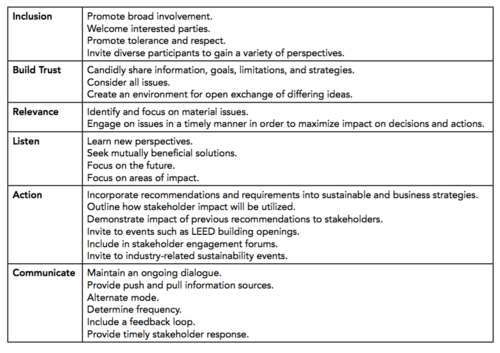
Select Indicators and collect data
Once defined the map and the impact areas, it is necessary to keep track of the performance.
The first thing to do is to identify indicators that better express the relationship between the company’s activities and their impact on sustainable development.
The company can find indicators or take inspiration from the SDG Compass Website. After, together with the stakeholders, the Logic Model,a tool that helps to identify which data collect,can be developed.
The Logic Models tracks the activities during 5 steps as showed in the Figure 5.

Define priorities
After having mapped the value chain, identified impact areas and collected data, the company can pursue to identify which are the priorities. For example, according to the probability to have positive or negative impacts on the SDGs, or the possibility to develop new products, broaden the market segment.
Setting Goals
Setting goals is necessary to obtain a good performance. There are four different steps to follow in order to define and achieve the goals:
Define scope of goals and select KPIs
Once identified the strategic priorities in the second step of SDG Compass, the company’s goals will automatically include opportunities to contribute positively to the SDGs. In this way the goals will generate value along the entire value chain.
It is recommended for the company to set goals, including all the aspects of the sustainability development: social, economical and environmental.
The basis to drive, monitor and control analytically the processes is selecting Key Performance Indicators (KPIs), as explained in the previous paragraph. For each priority, the company should select few key indicators. However, it is important to use indicators that are common among companies, in order to be able to compare data easily. And whenever the company needs a specific indicator, KPIs for specific business operations can be generated.
Define baseline and select goal type
The company has to define a baseline for every goal, accordingly to the impact assessment. The baseline has to be defined transparently, defining the reason why it is chosen. In case, there are changes that can impact and change the information gathered,also a new baseline should be calculated.
Moreover, the organization has to choose if follow absolute goals (which consider only the KPI) or relative goals (which compare the KPI to a unit of output).
One on hand the absolute goals are sure, giving the expected impact on society, but they do not consider the company growth. On the other, the relative goals measure the company's performance per unit of output, but the goal impact is unsure. There is no goal that can provide a real picture, the important thing is to know what kind of impact the company wants to achieve.
Set level of ambition
The company needs to be transparent with all the stakeholders on defining the level of ambitions it has regarding the goals. The more the company is ambitious the more the probability to drive grater impacts and have better performance is high.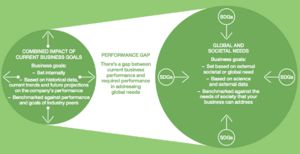
There are two different goal setting approach to apply:
- The Inside-Out approach : looking into past performance, trends and scenarios, but it is not enough to address global needs.
-The Outside-In approach: looking at what the global needs are and set the company's goals accordingly. The SDGs represents a political consensus, providing the level of progress desired at global level.
Announce commitment to SDGs
The company has to communicate the goals and express clearly where it is in the sustainability journey, in order to avoid risks of criticism. Whenever the company does not meet the targets on time, it is suggested to communicate regularly the progresses achieved and the effort made, resulting transparent and engaging.
Integrating
This forth step considers the moment in which the sustainability is integrated within the core business. This step transforms all the aspect of the company's core business, with products, services, customer segments, supply chain management, etc. The integration of the SDGs in the organization business needs to follow some actions:
Anchoring sustainability goals within the business
For business integration of SDGs, an active leadership by the CEO and the senior manager is very important. They have to engage the organizational members to pursuit in the sustainability journey. They can both communicate how progress towards sustainability goals create values for the company and integrate sustainability goals into performance reviews and remuneration schemes, with incentives when a member of the company achieves a certain goal.
The integration, to be more effective, should be comprised in financial, strategic and operational goals, and also in the vision, mission and statement of purpose of the company.
Embed sustainability across all functions
When sustainability is integrated, every function of the company,such as R&D, Business Development, Supply Chain Management, Operations and Human Resources,has an importance and a certain role, depending on its nature. The company can establish cross-functional sustainability councils, boards or task forces to support the sustainability development, being facilitated and aware on defining sustainability priorities. The following graph, (Figure 7) gives a big picture of the sustainability integration through the company's functions.
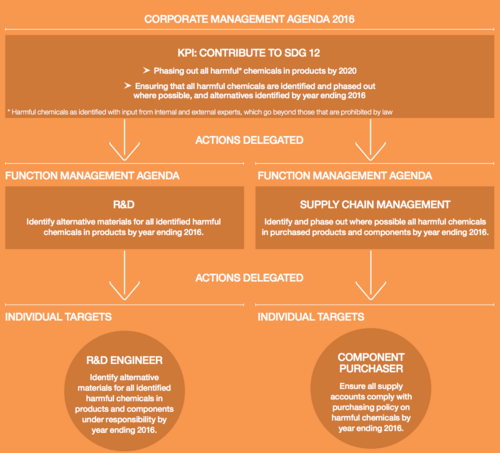
Engage in partnership
The company, in order to pursue successfully the sustainable development, should develop also partnerships. Either along the value chain, sharing resources and launching new products into the market; or as sector initiatives promoted by managers to share the same goals; or multi-stakeholder partnership, with government and private sector.
These partnerships are important for sharing the same values, goals and priority of the company, SDG Target 17.6. [19]
Reporting and Communicating
The SDG target 12.6 invites companies to report and communicate their sustainability progresses in their report because it is very important that internal and external stakeholders are able to be adjourned continuously. The actions that the company can do in order to outline transparency are the following two:
Effective reporting and communication
The Compass website provides some framework that the company can use for the sustainability reporting and whenever the company wants to explain more personally and deeply its actions can prepare a more detailed report. However, the company should always follow international standards as the one given by GRI's Sustainability Reporting Standards[20]. They invite and encourage companies to write sustainability reports and give also some guidelines, including in the report process: stakeholder, sustainability context, materiality, completeness, balance, comparability, accuracy, timeliness, clarity and reliability. Those principles will be reflected in the company context, environment, processes, economy and will provide a better understanding of the company's performance related to SDGs.
Communicating on SDG performance
The organization that refers to SDGs have implemented a common language with the other companies and stakeholders and will facilitate the evaluation of progresses and asses where it is located in the value chain. Explaining the contribution in the economic, social and environmental issues it has given.
The organization can communicate all the tools and instruments it is adopting for the sustainability journey to spread the informations and results as transparent as possible. It can refer to SDGs, explaining: the reasons why the chosen SDGs are important for the organization, the positive or negative impacts that the company has on the SDGs, which strategies the company is adopting in order to regulate the impact to SDGs.
Circular Value Chain
The value chain is analyze in order to obtain alignment between business and sustainability goals. Then, it has to be understood that the reduction of the Greenhouse gas (GHG) emissions through the value chain, the internal and external operations and the impacts of the company, .
The organization should face a change of the value chain perspective, from the linear one (Paragraph 2: supplies, production/operations, distribution, product and use), to a circular one, that starts from the early stage of the product supplies and ends with the recycle of the product. This approach is called the "Life Cycle Assessment" (LCA) of the product, and refers to a circular economy that allows the reduction of the costs and resources in every stage of the product´s life cycle [21].
Life Cycle Assessment
Life cycle assessment (LCA) "Is a methodological framework to estimate and assess the environmental impacts attributable to the life cycle of a product, such as climate change, stratospheric ozone depletion, smog creation, eutrophication, acidification, toxicological stress on human health and ecosystems, the depletion of resources, water use, land use, and others". [9]
It gives a sustainable perspective of the product design, source and development. It provides also a clear overview of the company's impact that leaders can communicate to stakeholders.
Furthermore, LCA gives several benefits to the company, such as improvements in the product design, in the recycle of products, in the use of natural resources. In general, assessing the product life in every stage is easier than reduce the impact on the entire amount of the operations. The circular process of LCA is showed in the Figure 8 [5].
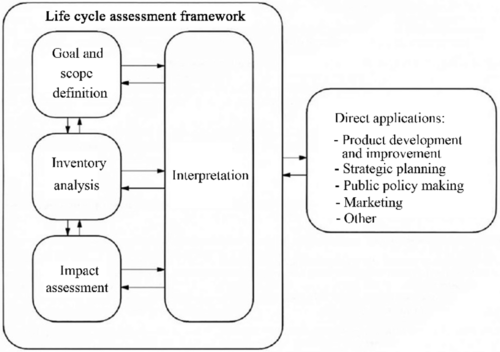
Benefits
The benefits gained from the alignment between business and sustainability strategies, reached once the Sustainability Journey is completed, are [5]:
- Risk mitigation
- Operational efficiencies
- Cost savings
However, the whole company components will benefits, such as :
- Improvement of engagement and productivity of the employees.
- Safeguard of natural resources of the environment.
- Community engagement, human rights, fair labor standard for internal and external stakeholders.
Limitations
Matching Sustainability goals with the business core values is a huge change process for the company, it requires transparency from CEO and senior managers. This means changing all the policies, people and processes, and one of the biggest challenges is the leadership during the changing process.
A bad leadership can be a failure for the company´s journey for different aspects:
- No engagement and gamification for people into processes drives to bad performances.
- No internal and external stakeholders interest includes lack of support.
In genereal, developing this change needs to have all the portfolio components involved, others limitation are:
- More expensive activities and products.
- Backlash from customers and stakeholders, if the information spread is not correct, or does not contain regulations.
- Lack of support.
Annotated Bibliography
Brief explanation of some of the references used in the Wiki-article
- Kristina Kohl , Becoming a Sustainable Organization: A Project and Portfolio Management Approach, © 2016 by Taylor & Francis Group, LLC[5]
- The book is addressed to project and portfolio managers of companies that are involved in sustainability change. It gives detailed explanations on how engage stakeholders to support the change and gives guiding measurements to assess if the company is doing well
- https://sustainabledevelopment.un.org/sdgs [1]
- The Sustainable Development Goals (SDGs) is a common action to achieve before 2030. The SDG contains 17 goals and 169 targets, integrated and indivisible, seeking to achieve the universal issues and solve them,as poverty, equality in human rights, in health, education, gender equality. Most of those problems can be solved by a common force and a Global Partnership, facilitating the implementation of the Goals and targets.
- http://sdgcompass.org/wp-content/uploads/2015/12/019104_SDG_Compass_Guide_2015.pdf [8].
- The SDG Compass is a guideline for companies to integrate sustainability into the core business of the company. It provides tools and methodologies to be applied at all the levels of the company.
- Sustainability Development and the company: why, what and how? - from the course 42351 Sustainability in Management. Technical University of Denmark. [4]
- The article explains the reason why companies should take care about sustainability. And examines all the past and the future opportunities for the companies.
References
Several references are directly linked in the text through its key word.
- ↑ 1.0 1.1 https://sustainabledevelopment.un.org/sdgs
- ↑ http://www.igi-global.com/dictionary/organizational-culture/21475
- ↑ https://en.wikipedia.org/wiki/Sustainability
- ↑ 4.0 4.1 Sustainability Development and the company: why, what and how? - from the course 42351 Sustainability in Management. Technical University of Denmark.
- ↑ 5.0 5.1 5.2 5.3 5.4 5.5 5.6 5.7 Kristina Kohl , Becoming a Sustainable Organization: A Project and Portfolio Management Approach, © 2016 by Taylor & Francis Group, LLC
- ↑ P.Sorenson, ‘Pollution Prevention Pioneer’ Inventing Tomorrow,1999
- ↑ http://www.wbcsd.org/home.aspx
- ↑ 8.0 8.1 8.2 8.3 8.4 8.5 8.6 8.7 8.8 https://www.unglobalcompact.org/docs/issues_doc/development/SDGCompass.pdf
- ↑ 9.0 9.1 Life cycle assessment:Part 1: Framework, goal and scope definition, inventory analysis, and applications- G. Rebitzer,T. Ekvallb,R. Frischknechtc,D. Hunkelerd,G. Norrise,T. Rydbergf,W.-P. Schmidtg,S. Suhh,B.P. Weidemai,D.W. Penningtonf
- ↑ https://www.unglobalcompact.org/what-is-gc/
- ↑ https://www.unglobalcompact.org/library/3111
- ↑ http://www.undp.org/content/undp/en/home/sustainable-development-goals/goal-12-responsible-consumption-and-production.html/
- ↑ http://www.undp.org/content/undp/en/home/sustainable-development-goals/goal-17-partnerships-for-the-goals.html/
- ↑ http://www.ghgprotocol.org/node/453/
- ↑ http://socialhotspot.org/user-portal-2/social-hotspot-index/
- ↑ http://hrbcountryguide.org/2013/06/human-rights-abuses-can-trigger-legal-financial-reputational-costs-for-companies-ruggie-tells-indonesian-ministry-of-foreign-affairs/
- ↑ http://www.wbcsd.org/work-program/sector-projects/water/global-water-tool.aspx
- ↑ https://www.oxfam.org/sites/www.oxfam.org/files/oxfam-poverty-footprint.pdf/
- ↑ http://stats.unctad.org/Dgff2016/partnership/goal17/target_17_6.html
- ↑ https://www.globalreporting.org/Pages/default.aspx
- ↑ http://www.lifecycleinitiative.org/starting-life-cycle-thinking/what-is-life-cycle-thinking/